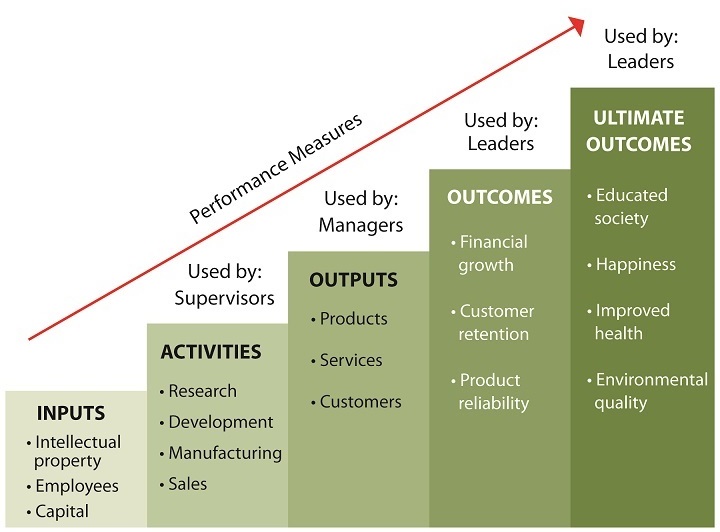Real trust can only grow when people know how the organization’s performance will be judged. In my experience, people align themselves around whatever is being measured like particles of iron around a magnet. That’s why the scorecard is such a critical part of sharpening the focus.

A scorecard needs to capture three different dimensions:
- What will be measured (the metric)
- What you’ll aim for (the target)
- The current performance (the baseline)
When measuring success, distinguish between inputs, activities, outputs, and outcomes. Outcomes measure the actual value you’re creating, like satisfied customers or financial profitability, and they are the key to high performance. This is shown here in the “stairway to performance.”
Too often I find organizations where leaders are deep in the weeds, tracking the number of sales calls per salesperson or quantity of units produced, not the results in terms of satisfied customers, retention of key clients, or profitability. Not only does this produce skewed performance measures but it also breeds turf battles. So when you’re putting together your scorecard, make sure you’re focusing on the right stuff.
Outcomes vs. Outputs
When a large healthcare system in California started measuring health outcomes, a surprising thing happened: patient health increased, while at the same time, healthcare costs declined. Why this surprising result? A major factor was that doctors started looking at the performance measures and teaming up to treat the sickest people. As a result, the number of “frequent fliers” – people who regularly sought medical care – decreased dramatically.
Paying attention to outcomes pays off in big ways. Yet many companies fail to take the time to systematically figure out how to measure performance. As a result, the business doesn’t flourish as it should. Instead, it stagnates.
When we work with our clients, we help them look holistically at the organization and develop a set of performance measures that track outcomes rather than outputs. We then help ensure that the information is communicated throughout the organization on a regular basis – via forums in which people talk about performance, look at trends, and focus on areas where the organization is not meeting its targets.
Sharing performance information in this manner aligns people around a common set of goals and focuses everyone’s attention on how to improve the organization’s performance. It also builds trust when people see that leaders are holding everyone accountable. Done well, a strong set of performance measures will raise the organization to a higher level of success.
LRI helps develop meaningful performance measures tied to your organization’s goals – and then helps you use those measures to drive continuous improvement.
Leading Resources, Inc. is a Sacramento Performance Management Consulting firm that develops leaders and leading organizations. Subscribe to our leadership development newsletter to download the PDF – “The 6 Trust-Building Habits of Leaders” to learn more about how to build trust with your team.
 Client Member Area
Client Member Area 
